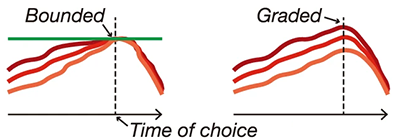 Whether a decision is easy or difficult, to make a decision is to narrow down a slate of options into a singular, definitive action. Even when the choice is as trivial as which entree to order off the menu, we’ve all experienced the pangs of indecisiveness; every decision means forgoing an infinite set of possibilities. The horns of dilemma are sharp.
Whether a decision is easy or difficult, to make a decision is to narrow down a slate of options into a singular, definitive action. Even when the choice is as trivial as which entree to order off the menu, we’ve all experienced the pangs of indecisiveness; every decision means forgoing an infinite set of possibilities. The horns of dilemma are sharp.
Philosophers, psychologists, economists, and neuroscientists have long been fascinated by the process by which we come to a decision, trying to pinpoint the factors that can make it easier or harder.
Now, new research from the University of Utah’s John and Marcia Price College of Engineering has shown that our propensity for uncertainty is rooted in the brain’s basic biology. Rather than yes-or-no or black-or-white, the act of deciding is defined by shades of gray, right down to the level of activity of neuronal ensembles.
Jan Kubanek, assistant professor in the Department of Biomedical Engineering at the U’s John and Marcia Price College of Engineering, along with members of his lab, collaborated with Matthew A. Adamo and Anthony L. Ritaccio of Albany Medical College and Jon T. Willie and Peter Brunner of the Washington University School of Medicine on the study. It was published in the journal Nature Communications.
In this study, the researchers aimed to experimentally settle a longstanding debate within neuroscience: do the brain’s decision-making mechanisms operate in black-and-white, or in a graded manner — in gradients of gray?

One possibility is that these mechanisms work like a “switch” — as you deliberate on a decision, the neural activity associated with one of the options eventually reaches a defined threshold that figuratively flips your preference from a “no” to a “yes.” Another is that there is no threshold; the signals associated with each option exist on a spectrum of intensity that is ultimately assessed at the time the decision is made.
“People objectively make black-and-white decisions and take black-and-white actions. But at the subjective level, we experience different levels of confidence associated with our decisions and actions,” says Kubanek. “This study now proves that, at the neural level, the signals associated with decisions are themselves uncertain! So it’s not just our subjective perception; confidence has a neural substrate.”
The researchers recruited study participants who already had deep brain electrodes implanted as part of treatments for intractable epilepsy, allowing them to record high-quality data on brain activity across multiple regions during their experiments.
In those experiments, the participants wore headphones in which the researchers played a series of clicks. The participants had to decide whether they had heard more clicks in their right or left ear, indicating their answer by either moving their eyes to one side or the other, or pressing a corresponding button.
The brain recordings revealed that the neural activity reflecting each individual’s decision-making process gradually increased as they heard the clicks, with distinct gradations appearing between “left” and “right.” Critically, this grading effect persisted throughout the decision process without ever reaching a definite bound at the time of choice.
“We also found this representation of confidence in the actual output that the participants indicated their decisions with,” says Kubanek. “When people make confident decisions, they enact them more firmly — they literally press the button harder. You can imagine that this has consequences for operators like pilots or someone pulling the trigger of a gun.”
Further research will generalize these findings to naturalistic tasks — such as deciding which item is more valuable. Moreover, future work will determine whether recordings of muscle activity could be used to determine the level of an operator’s confidence, and correct actions that were formed as a consequence of poor, uncertain choices.
—###—
Graded decisions in the human brain
Tao Xie, Markus Adamek, Hohyun Cho, Matthew A. Adamo, Anthony L. Ritaccio, Jon T. Willie, Peter Brunner & Jan Kubanek
Nature Communications
https://doi.org/10.1038/s41467-024-48342-w
This work was supported by the National Institutes of Health (NIH) grants R01-MH120194 (to J.T.W.), R01-EB026439 (to P.B.), U24-NS109103 (to P.B.), U01-NS108916 (to P.B.), U01-NS128612 (to P.B.), P41-EB018783 (to P.B.), R00-NS100986 (to J.K.), RF1-NS128569 (to J.K.). T.X. was supported by the Brain & Behavior Research Foundation (NARSAD Young Investigator) and the McDonnell Center for Systems Neuroscience. P.B. was also supported by the McDonnell Center for Systems Neuroscience and the Fondazione Neurone. J.T.W. was also supported by the American Epilepsy Society fellowship award (Research and Training Fellowships for clinicians)